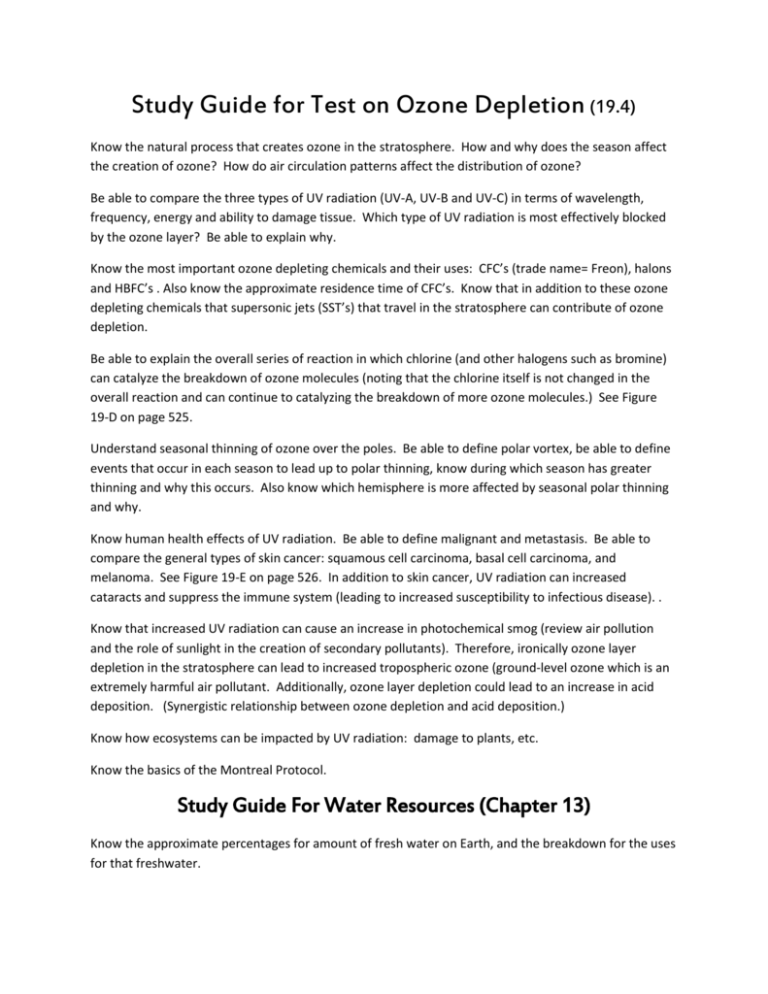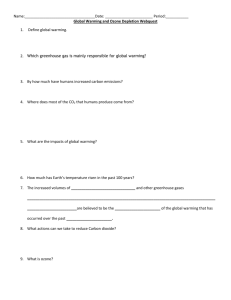Study Guide for Test on Ozone Depletion (19.4) Know the natural
advertisement

Study Guide for Test on Ozone Depletion (19.4) Know the natural process that creates ozone in the stratosphere. How and why does the season affect the creation of ozone? How do air circulation patterns affect the distribution of ozone? Be able to compare the three types of UV radiation (UV-A, UV-B and UV-C) in terms of wavelength, frequency, energy and ability to damage tissue. Which type of UV radiation is most effectively blocked by the ozone layer? Be able to explain why. Know the most important ozone depleting chemicals and their uses: CFC’s (trade name= Freon), halons and HBFC’s . Also know the approximate residence time of CFC’s. Know that in addition to these ozone depleting chemicals that supersonic jets (SST’s) that travel in the stratosphere can contribute of ozone depletion. Be able to explain the overall series of reaction in which chlorine (and other halogens such as bromine) can catalyze the breakdown of ozone molecules (noting that the chlorine itself is not changed in the overall reaction and can continue to catalyzing the breakdown of more ozone molecules.) See Figure 19-D on page 525. Understand seasonal thinning of ozone over the poles. Be able to define polar vortex, be able to define events that occur in each season to lead up to polar thinning, know during which season has greater thinning and why this occurs. Also know which hemisphere is more affected by seasonal polar thinning and why. Know human health effects of UV radiation. Be able to define malignant and metastasis. Be able to compare the general types of skin cancer: squamous cell carcinoma, basal cell carcinoma, and melanoma. See Figure 19-E on page 526. In addition to skin cancer, UV radiation can increased cataracts and suppress the immune system (leading to increased susceptibility to infectious disease). . Know that increased UV radiation can cause an increase in photochemical smog (review air pollution and the role of sunlight in the creation of secondary pollutants). Therefore, ironically ozone layer depletion in the stratosphere can lead to increased tropospheric ozone (ground-level ozone which is an extremely harmful air pollutant. Additionally, ozone layer depletion could lead to an increase in acid deposition. (Synergistic relationship between ozone depletion and acid deposition.) Know how ecosystems can be impacted by UV radiation: damage to plants, etc. Know the basics of the Montreal Protocol. Study Guide For Water Resources (Chapter 13) Know the approximate percentages for amount of fresh water on Earth, and the breakdown for the uses for that freshwater. Know the basic hydrology terms: watershed, surface water, groundwater, aquifer (confined and unconfined), recharge area, infiltration, percolation. Know the pros and cons of each of the ways to supply more water to regions: groundwater, dams and reservoirs, water transfers, and desalinization. Know several examples of each of the ways to supply more water. Know several ways to reduce water waste in irrigation, cities, homes, etc. Know the causes, both natural and anthropogenic, of flooding. Know basic prevention and river control techniques for reducing flood damage. Know the basics of the water resource presentations.






